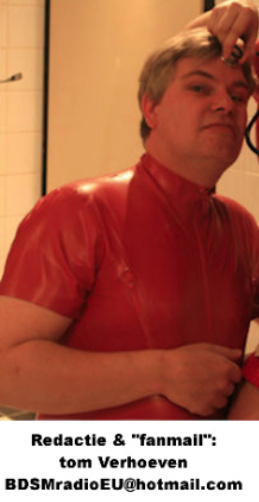Source: Messynessychic.com
FRANCE – PARIS – The Années Folles in Paris — a time for jazz, literature of the Lost Generation, and a little-known fetish fashion boom. Spearheaded by a husband and wife team largely forgotten by history, Nativa Richard and her husband L. Richard, were the dynamic duo behind a groundbreaking brand called Yva Richard, and opened the world’s first known fetish boutique in Paris. The Richards were busy stitching dreams—or nightmares, depending on your perspective – one leather corset at a time. While the world was dealing with the prelude to World War I, the Richards were creating costumes, hats, shoes, and high-class lingerie. Their boutique was a haven for the fashion-forward and the faintly risqué. But oh, how things escalated.

They founded the company in 1914, just a few weeks before the outbreak of World War I, but by the late 1920s, it had become a successful mail-order business, as well as a photographic studio catering ro a growing demand for erotic prints. Nativa, a talented seamstress, became the fearless face (and body) of their brand and in-house photography. She was a curly-headed mature blonde woman, with a soft, plush, plumply voluptuous figure, shapely legs. Her fetish characters had names such as “Helios” and “Miss Milado”, but she also proudly went by her own name, Nativa. Her penchant for exhibitionism was evident.
Mr. Richard, who we know very little about (his first name might have been Louis) took a lot of the photographs, but they also cleverly collaborated with some of the era’s photographic elites, including H. Manuel and Ostra Studio. Their bondage, whipping, and spanking imagery ensured that Yva Richard wasn’t just pushing boundaries — they were bulldozing them
Yva Richard’s pièce de résistance? The infamous La Lingerie Moderne catalog. It was a mail-order marvel that found its way into the hands of the adventurous and the curious through gentlemen’s magazines like La vie parisienne and Le sourire. These catalogs were the 1920s equivalent of the internet: a secret window into a world of leather corsets, high-heeled boots, handcuffs, and more.
By the 1930s, the catalog had expanded to include a veritable smorgasbord of fetishistic accessories. Leather, rubber, metal—if you could wear it (or be restrained by it), Yva Richard sold it. Dog collars with leashes, masks, and bizarre dominatrix ensembles made even the most jaded Parisians do a double-take.
The Richards only had one rival to worry about, which also happened to be another pioneering husband and wife duo. Also based in Paris, Diana Slip was founded by Léon Vidal and his wife, Diana. The company quickly became known for its own daring designs and risqué photography. Much like Yva Richard, Diana Slip offered a range of fetishistic attire, including leather lingerie, high-heeled boots, and bondage gear.
Diana Slip was known for its avant-garde approach and collaboration with renowned photographers, including Brassaï and the Biederer Studio. Their work appeared in many of the same publications as Yva Richard’s, such as La Vie Parisienne and Le Sourire, ensuring a competitive, yet creatively rich, atmosphere in the Parisian fetish scene.
World War II however, came stomping in like an uninvited guest, and the once-thriving fetish fashion scene took a hit. The Nazi occupation of France in 1943 meant the end for Yva Richard and its contemporaries. The shop closed its doors, leaving behind a legacy that was as bold and brazen as the outfits it sold.
In America, Charles Guyette is regarded as the godfather of fetish art (later crowned the “G-String King”) producing and distributing film, fashion and print. He also plagiarized Yva Richard’s designs at his New York shop. Later crowned the “G-String King,” his key contribution was fetish photography featuring thigh-high boots, sharp heels and gartered fishnet stockings with supporting props of whips and hand-cuffs. Guyette was largely unknown in his own lifetime and operated under umbrellas of aliases, but those American and Canadian exponents who succeeded him – Irving Klaw, John Willie and Eric Stanton – would become part of an infamous circle of patrons, publishers, and subculture personalities described by fetish art historian Richard Pérez Seves has designated as the “Bizarre Underground.”
Despite its untimely demise, Yva Richard’s influence didn’t vanish into obscurity. The next generation of artists, including John Willie and Irving Klaw, found inspiration in their daring designs. Following in Charles Guyette’s footsteps in North America, Irving Klaw, John Willie and Eric Stanton – would become part of an infamous circle of patrons, publishers, and subculture personalities described by fetish art historians as the “Bizarre Underground.” In the 1950s, models like Bettie Page could be seen donning outfits strikingly similar to those once modeled by Nativa Richard herself.
A testament to their enduring impact is Alexandre Dupouy’s book, “Yva Richard, L’âge d’or du fétichisme,” which chronicles this golden age of fetishism. It’s a must-read for anyone curious about the roots of modern erotic fashion.
So, the next time you slip into something a little less comfortable, give a nod to Yva Richard and Diana Slip. They walked so today’s fetish fashionistas could strut in sky-high heels and leather corsets. And remember, behind every great dominatrix ensemble, there’s a seamstress who dared to dream a little kinkier.
From BDSMeadio.EU
Tip for BDSM Vintage Art Photo lovers: Yvarichardstudio.wordpress.com and Vintagebdsmart.com
Greetings.
tom Verhoeven


